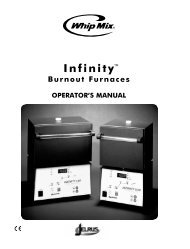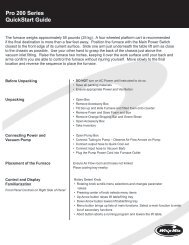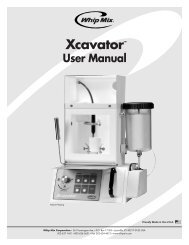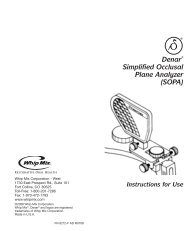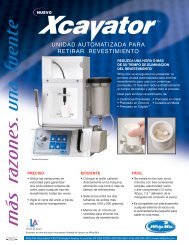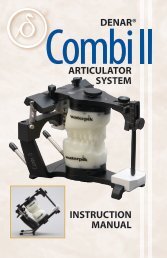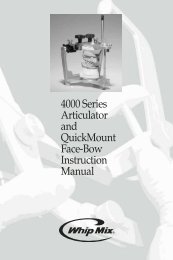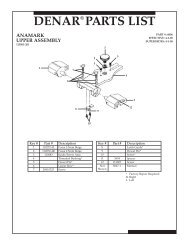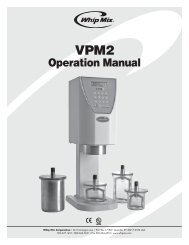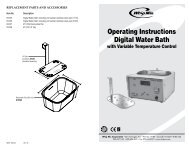DENAR® TRACK II SYSTEM - Whip Mix
DENAR® TRACK II SYSTEM - Whip Mix
DENAR® TRACK II SYSTEM - Whip Mix
You also want an ePaper? Increase the reach of your titles
YUMPU automatically turns print PDFs into web optimized ePapers that Google loves.
Table of ContentsI. The Track <strong>II</strong> Articulator• Centric Lock Operation 6• Centric Positioner 6• Adjustments 6• Articulator Manipulation 8<strong>II</strong>. The Slidematic Facebow• Assembling on the Patient 10• Transferring to the Articulator 12<strong>II</strong>I. Mounting the Casts• Maxillary Cast 13• Mandibular Cast 14IV. Setting the Condylar Controls• Protrusive 15• Progressive Sideshift 15• Immediate Sideshift 16AppendicesA. D31 AB Facebow/Earbow 18B. Care and Maintenance 19C. Accessories 205
forward pressure with the left thumb inlateral excursive movements. In addition,when the incisal pin is pushedto the left, the back of the articulatorshould also be pushed to the left(underhand push grasp) (Fig. 10).Conversely, when the incisal pin ispulled to the right, the back of thearticulator should be pulled to the right(underhand pull grasp) to ensure thatthe articulator functions in accord withits condylar adjustment settings. Toeffect a straight protrus movement theupper bow is moved straight posteriorlyguided by both hands (Fig. 11).• Adjustment LimitationsThe Track <strong>II</strong> has an extremely longcondylar track allowing the condyles15 millimeters of protrusive and lateralmovement. This movement is limitedto 11 mm when progressive sideshift isset to 30°.FIG. 119
10MEASURING BOW41. earplug2. anterior reference pointer3. intercondylar distance scale4. “finger” lockscrew5. Center “lock” wheel6. Sight5216reference plane locater3TRANSFERJIG ASSEMBLY3421. dentulous bitefork2. bitefork index notch3. vertical shaft4. articulator index1reference plane marker<strong>II</strong> THE SLIDEMATICFACEBOWFacebow TransferThe facebow transfer procedure establishesthe relationship of the maxillarydentition to the horizontal referenceplane so that the maxillary cast may bemounted on the articulator in the correctanatomical position. The SlidematicFacebow provides a fast, easy andextremely accurate means of transferringthe proper anatomical relationship to thearticulator. Any Denar ® facebow may beused for mounting the maxillary cast tothe Track <strong>II</strong>. In this chapter only the proceduresrelating to the Slidematic faceboware described. However, the Denar ®D31AB Facebow/Earbow may also beused (see Appendix B).Assembling the Slidematicon the PatientMark the anterior reference point on thepatient’s right side using the ReferencePlane Locator and Marker. The point is43 millimeters above the incisal edge ofthe right central or lateral incisors (seeFigure 12). On an endentulous patient,measure up from the lower border of the
FIG. 12 FIG. 13 FIG. 14upper lip when it is in repose.Cover the metal with two thicknesses ofbaseplate wax softened in warm water(approximately 135˚F or 55˚ C). Withthe bitefork arm to the patient’s right,place the fork in the mouth, aligning thepatient’s midline with the index notch, sothat it is parallel with the patient’s coronaland horizontal planes (see Figure 13).Be certain to obtain a light indexing ofthe patient’s maxillary arch and then askthe patient to hold the bitefork in place.Attach the vertical shaft to the measuringbow with the clamp marked #2 onthe patient’s right and tighten the fingerscrew (see Figure 14). It is necessaryto tighten this finger screw to securethe vertical shaft to the measuring bowand also to avoid movement. This samemovement will occur after inserting thevertical shaft in the articulator index asshown in Figure 23. Be sure to tightenthe finger screw.Loosen the finger screws on the clampsmarked #1 and #2 on the vertical shaft.With your thumb, loosen the centerwheel on the top of the measuring bowand slide the bow open to accommodatethe width of the patient’s face. Assemblethe facebow on the patient by sliding thebitefork arm through the hole in clamp#2 as the measuring bow’s earpieces areplaced in the patient’s auditory meatus(see Figure 15). Tighten the center wheelon the measuring bow and loosen thefinger screw on the anterior referenceFIG. 15pointer. Raise or lower the bow so thatthe pointer or sight aligns precisely withthe anterior reference point (see figure16) and tighten clamp #1, then clamp#2 (see Figures 17 and 18). When tighteningclamps #1 and #2, care must betaken not to displace the bow to eitherside by having the vertical shaft rest on11
FIG. 16FIG. 18FIG. 2012FIG. 17the fingers as shown in Figure 17. Thepatient’s inter-condylar distance is themeasurement indicated on the scale (seeFigure 19). Record this measurement.Loosen the finger screw on the measuringbow, slide the bow open, andremove the entire facebow from thepatient.FIG. 19Detach the measuring bow from thetransfer jig by loosening the finger screw(see Figure 20). Having completed theprocedures involving the patient, thebitefork assembly (see Figure 21) may belabeled with the patient’s name and setaside while the measuring bow portioncan be used with an additional biteforkassembly for the next patient.FIG. 21Note: The metal bitefork, vertical shaftand earpieces can be sterilized in anautoclave EXCEPT for the black fingerscrews on the #1 and #2 clamps.Remove the finger screws (and spacers)before autoclaving or use cold sterilization.Sterilize bitefork before each use.
<strong>II</strong>I MOUNTING THE CASTSA benefit of using the Denar ® SlidematicFacebow is that multiple transfer jigsmay be used with only one measuringbow. Although it is not always recommended,the mounting of the maxillarycast can be delegated to the laboratory,involving no loss of accuracy and noperiod of time without facebow transfercapability in the dental office. The laboratorycan attain an articulator index fortheir own Denar ® articulator and mountthe maxillary cast using only the biteforkassembly from the dental office. Eacharticulator index positions the biteforkassembly on any Denar ® articulator sothat the relationship with the condylesrecorded on the patient is accuratelyreproduced on the articulator.Mounting the Maxillary CastReplace the incisal table on the articulatorwith the articulator index (see Fig.22). With the numbers on clamps #1 and#2 in the upright position, secure thereference pin of the bitefork assembly inthe hole of the articulator index. Tightenthe lockscrew on the front edge of theindex (see Fig. 23).Attach a mounting plate to the upperbow. Be sure that the incisal pin is at thezero position and that the upper bow islevel and parallel to the table top.FIG. 22The position that the incisal pin sits onthe articulator index is determined by thetype of incisal pin being used. The incisalpin (110092) with the long centric adjustmentfoot (used with the 110109 or110241 incisal table) sits on the highestsection of the movable insert. The roundlong incisal pin (300042, used with the110193 incisal table) sits in the center ofthe index. The round, short incisal pin(300200-1), used with the 110240 incisaltable) sits on the movable metal piece inFIG. 23the center of the index (see Fig. 24). Insituations where the Slidematic facebowis being used with the same articulator,secure the movable metal insert with adrop of wax once the insert’s appropriatelocation has been determined.13
Mounting the Mandibular CastAttach a mounting plate to the lowerbow. A centric relation checkbite recordis used to mount the mandibular cast.With the maxillary cast attached tothe articulator and the centric locksengaged, invert the articulator and placethe centric relation checkbite recordbetween the maxillary and mandibularFIG. 24Place the maxillary cast in the wax indexon the bitefork, close the articulator,and mount the cast with stone to themounting plate (See Fig. 25) . Normally, amaxillary cast support is not necessary,although one may be used, if desired.Once the stone has hardened, removethe transfer jig and replace the incisaltable in the articulator.FIG. 25FIG. 26casts (See Fig. 26). Stabilize the positionof the casts with either a rubber bandor sticky wax. Adjust the incisal pin toaccommodate the increased verticaldistance caused by the thickness of thecentric relation bite record.14
Double check to be certain that thecondyles are seated against the rear ofthe fossae, and using stone, proceed tomount the mandibular cast to the mountingplate on the articulator (See Fig. 27).FIG. 27IV SETTING THECONDYLAR CONTROLSThe Track <strong>II</strong> articulator features threecondylar path of movement adjustments:1) protrusive condylar path; 2) progressivesideshift and 3) immediate sideshift.The operator may select any of the followingalternate methods for makingthese adjustments dependent upon hisor her specific requirements and preference.PROTRUSIVE1. Arbitrary method. Set to 30 degrees.(This inclination is sufficiently low toeliminate almost all protrusive interference.)2. Checkbite method. Loosen the protrusiveand progressive sideshift adjustmentson both sides of the articulator.Disengage the centric positioner. Setthe protrusive checkbite record oneither cast. Move the opposing cast inthe protrusive position and seat it intothe checkbite record. If the cast doesnot seat accurately, apply very lightpressure to the bow of the articulatorand rock the protrusive adjustmentsback and forth until the most accurateseating of the casts into the recordis achieved (Fig. 28). (This proceduremust be done very carefully so as notto modify the record.) Lock the protrusiveand progressive sideshift adjustmentlock screws.PROGRESSIVE SIDESHIFTa. Average Anatomic Setting: = 7°b. Arbitrary Setting: = 7+°c. Lateral Checkbite (procedureexplained below without incorporatingthe immediate sideshift)15
16IMMEDIATE SIDESHIFT1. Arbitrary adjustment. Setting thisadjustment to zero provides for tightcoupling of the centric holding cuspsin the position of maximum intercuspation.Increasing the immediate sideshiftadjustment in treatment providesfor greater lateral freedom in the positionof maximum intercuspation.For example:0 mm = tight intercuspation0.5 mm = slight lateral freedom1.0 mm = moderate lateral freedom1.5 mm = greater lateral freedom2. Lateral checkbite method. Condylarpath of movement studies* haveshown that in almost all patients oncethe immediate sideshift has occurredthe orbiting (balancing) condyle movesforward on a path inclined 7° mediallyto the saggital plane (progressive sideshift).*Luncleen, Harry C. and Wirth, CarlG. Condylar Movement PatternsEngrated in Plastic Blocks, Journal ofProsthetic Dentistry, December 1973,pages 870-873.Therefore in this technique, due to inherentdifficulties and potentials for errorin obtaining accurate lateral checkbiterecords and setting the articulator tothese records, more accurate results canbe achieved by assuming the patient hasa progressive sideshift of 7° and usingthe lateral records only to set the immediatesideshifts.When setting the immediate sideshiftadjustment to lateral checkbite records:a. Set both sides of the articulator to thefollowing adjustments:Progressive Sideshift: 7° lockedProtrusive: 30° unlockedImmediate sideshift: 2 mm (screwsturned counterclockwisetwofull revolutions).b. Seat the right lateral checkbite recordbetween the casts with the articulatorin a right lateral mandibular bow position.While maintaining a slight pressureon the bows, rock the left protrusivepath adjustment back and forthuntil the most accurate seating of thecast into the record is achieved. (Thisprocedure must be done very carefullyso as not to modify the record.) Onoccasion you will note that the castwill not seat accurately on the rotatingside. (In this instance, right side.)This is because the patient’s rotatingcondyle may have also moved up ordown and backward or forward as itmoved out and this condylar positionwas reflected in the checkbiterecord. However, seat it as accuratelyas the articulator will allow. To setthe immediate sideshift turn the rightadjustment screw clockwise with thekey provided until the screw headlightly touches the lateral aspect ofthe condylar element. Now removethe checkbite record and lower theincisal pin to disengage the posteriorteeth and lock it in this position. Withthe key provided turn the immediatesideshift adjustment screw clockwiseand count the revolutions required toachieve the most close position. Thethread of the screw provides for 1 mmof immediate sideshift for each complete360° revolution. A quarter turn(90°) represents 0.25 mm of immediatesideshift. Now the measurement hasbeen made and should be recordedon the patient’s record. Resetting the
immediate sideshift to this measurementwill allow the instrument to morefaithfully simulate the immediate sideshiftof the patient. The measurementof the left immediate sideshift is donein the same manner utilizing a left lateralcheckbite record.DISCUSSION: A lateral checkbiterecord is a positional record in that itrecords only one position of the orbitingcondyle. This condylar positionreflects the patient’s unique combinationof any immediate and progressivesideshift movements. However, thereare many combinations of immediateand progressive sideshift articulatoradjustments which can achieve thissame condylar position. In the pastmany articulators had only progressivesideshift adjustments without any provisionfor immediate sideshift movement.When lateral checkbite recordswere used to set such an instrumentthe total sideshift was reflected in thearticulator only as progressive sideshift.One school of thought contendsthat in this usage the cusps tend tobe more tightly coupled in the positionof maximum intercuspation, generallyrequiring more occlusal correction oninsertion of the restoration and thecuspal inclines of the posterior teethtend to be more reduced becauseof the greater progressive sideshiftadjustment.Restorations developed on an instrumentthat produces an immediatesideshift will typically feature a greaterfreedom (and possibly less occlusalcorrection on insertion) in the positionof maximum intercuspation. Inthis usage, since the total sideshift isdivided into immediate and progressivecomponents, the progressivecomponent decreases as the immediatecomponent increases to arrive atthe same condylar position recordedby a lateral checkbite record. Thecontention is that this will result inincreasingly steeper cusps especiallyin the area of the balancing inclines ofposterior teeth on the orbiting (balancing)side.As previously stated, when an articulatorfeaturing both immediate and progressivesideshift adjustments is set tolateral checkbite records, one procedureis to set the progressive sideshiftto the average anatomy dimensionof 7°, and use the lateral records tomeasure only the immediate sideshiftcomponents. The protrusive adjustmentis set to the protrusive checkbiterecords. These articulator settingsare used in diagnostic proceduresand occlusal analysis. In treatmentprocedures the progressive sideshiftadjustments may be increased to 7°+to insure non contact of the balancinginclines (buccal lingual) of cuspson the orbiting side. The greater theincrease in the progressive sideshiftmovementthe greater the clearance ofthese cuspal inclines (ie., a 15° settingwill provide for greater clearance thana 10° setting).17
APPENDIX A–D31AB FACEBOW/EARBOWThe Denar ® D31AB Facebow/Earbow isanother accessory facebow that can beused to establish the relationship of themaxillary structures to the horizontal andvertical reference plane so the maxillarycast may be mounted on the articulatorin the correct anatomical position.The Denar ® D31AB Facebow/Earbowprovides an extremely accurate meansof transferring the casts through eitherearbow or facebow registration.The use of the D31AB involves threesimple procedures:a. Locating three reference points: oneanterior and two posterior, either theears or the hinge axis.b. Assembling the facebow/earbow onthe patient.c. Transferring the facebow/earbow tothe articulator.The Denar ® D31AB Facebow/Earbowconsists of standard facebow/earbowsidearms, crossbar, dentulous bitefork,and all necessary accessories. Orderpart #101437.When using as an earbow transfer tohole on side of fossa as pictured.18
APPENDIX B–CARE AND MAINTENANCEYour <strong>Whip</strong> <strong>Mix</strong> articulator is a precisioninstrument and requires care and maintenance.Periodic cleaning and lubricatingas described below will assure prolongedlife and dependable service fromthe instrument. Failure to follow theseinstructions will void your warranty.Cleaning– Use a mild soap and watersolution with the aid of a brush to dissolveaccumulations of wax and to washaway carborundum grit. Then air dryand lubricate. DO NOT use strong detergents,alkalies, gasoline or naphtha ascleaning agents!Lubrication– Lubricate the working andbearing components with a thin film ofsewing machine or high speed handpiecetype oil. Wipe off excess oil toprevent accumulations of dust or grit. Athin coating of petroleum jelly must beapplied to all articulator surfaces that willbe contacted by the gypsum mountingmaterial.Storage– Store the articulator in a clean,dry atmosphere free of plaster andCarborundum dust; away from acids,alkalies, or corrosive medicaments.Wait a full day after mounting castsbefore storing the articulator in a carryingcase. Moisture dissipation fromthe stone in an enclosed area causesalkalinity of the stone mixture which candamage the articulator surface.WARRANTY<strong>Whip</strong> <strong>Mix</strong> Corporation warrants thearticulator system to be free fromdefects in material and/or workmanshipfor a period of one year. In the eventof a defect, please notify the factory inwriting of the defect prior to returning theinstrument. <strong>Whip</strong> <strong>Mix</strong> Corporation will, atits option, either repair, replace or issuecredit for such defects.Because <strong>Whip</strong> <strong>Mix</strong> Corporation iscontinually advancing the design of itsproducts and manufacturing method, itreserves the right to improve, modify ordiscontinue products at any time, or tochange specifications or prices withoutnotice and without incurring obligations.19
APPENDIX C–ACCESSORIESIncisal Pins and TablesP2T2Pin:Long Centric/Adjustable Foot(110093)Table:Custom Platform, step(110241)P4T4Pin:Short Roundwith support(300270)Table:Custom Platform, flat(110240)Maxillary Cast Support (003401-000)Works with both magnetic andtraditional plates.P2T3Pin:Long Centric/Adjustable Foot(110093)Table:Adjustable(110109)P6T6Pin:Tapered(110509)Table:Adjustable(110635)Slidematic Facebow with threeDenar ® transfer jigs; (200011-6)20
D31AB Facebow/Earbow(See Appendix A)Magnetic Mounting SystemConverter Plates (20002367)Disposable Magnetic Mounting Plates,bag of 20 (20002368)Denar/Hanau Verification Gage(20011650)Disposable Mounting Plates, bag of10 (1100026-10)Articulator Carrying Case (110293-1)Universal Occlusal Stand (20011720)21
<strong>Whip</strong> <strong>Mix</strong> Corporation361 Farmington AvenueLouisville, KY 40209Toll-Free: 1-800-626-5651Fax: 1-502-634-4512www.whipmix.com© 2011 <strong>Whip</strong> <strong>Mix</strong> CorporationDenar ® and logo are registered trademarks of <strong>Whip</strong> <strong>Mix</strong> CorporationFN 8111-F AF R0911



